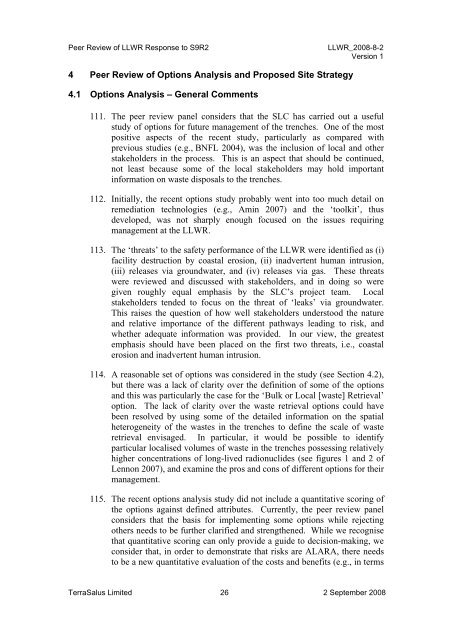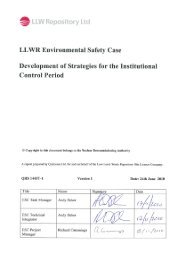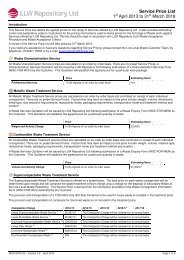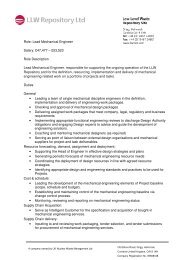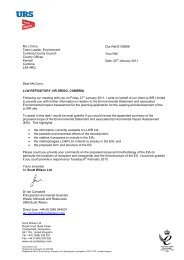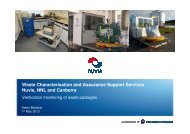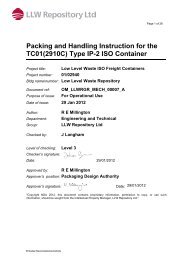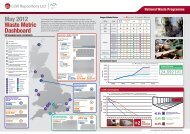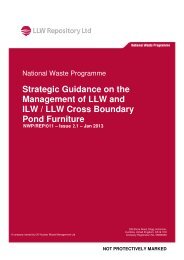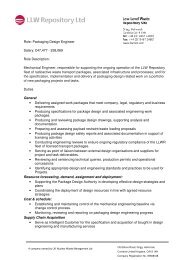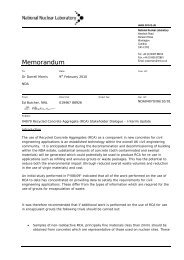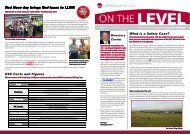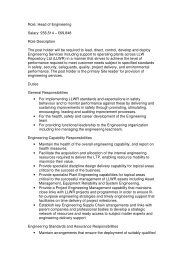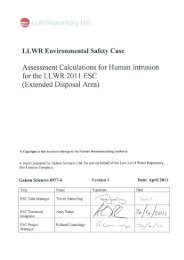Independent Peer Review of - Low Level Waste Repository Ltd
Independent Peer Review of - Low Level Waste Repository Ltd
Independent Peer Review of - Low Level Waste Repository Ltd
You also want an ePaper? Increase the reach of your titles
YUMPU automatically turns print PDFs into web optimized ePapers that Google loves.
<strong>Peer</strong> <strong>Review</strong> <strong>of</strong> LLWR Response to S9R2LLWR_2008-8-2Version 14 <strong>Peer</strong> <strong>Review</strong> <strong>of</strong> Options Analysis and Proposed Site Strategy4.1 Options Analysis – General Comments111. The peer review panel considers that the SLC has carried out a usefulstudy <strong>of</strong> options for future management <strong>of</strong> the trenches. One <strong>of</strong> the mostpositive aspects <strong>of</strong> the recent study, particularly as compared withprevious studies (e.g., BNFL 2004), was the inclusion <strong>of</strong> local and otherstakeholders in the process. This is an aspect that should be continued,not least because some <strong>of</strong> the local stakeholders may hold importantinformation on waste disposals to the trenches.112. Initially, the recent options study probably went into too much detail onremediation technologies (e.g., Amin 2007) and the ‘toolkit’, thusdeveloped, was not sharply enough focused on the issues requiringmanagement at the LLWR.113. The ‘threats’ to the safety performance <strong>of</strong> the LLWR were identified as (i)facility destruction by coastal erosion, (ii) inadvertent human intrusion,(iii) releases via groundwater, and (iv) releases via gas. These threatswere reviewed and discussed with stakeholders, and in doing so weregiven roughly equal emphasis by the SLC’s project team. Localstakeholders tended to focus on the threat <strong>of</strong> ‘leaks’ via groundwater.This raises the question <strong>of</strong> how well stakeholders understood the natureand relative importance <strong>of</strong> the different pathways leading to risk, andwhether adequate information was provided. In our view, the greatestemphasis should have been placed on the first two threats, i.e., coastalerosion and inadvertent human intrusion.114. A reasonable set <strong>of</strong> options was considered in the study (see Section 4.2),but there was a lack <strong>of</strong> clarity over the definition <strong>of</strong> some <strong>of</strong> the optionsand this was particularly the case for the ‘Bulk or Local [waste] Retrieval’option. The lack <strong>of</strong> clarity over the waste retrieval options could havebeen resolved by using some <strong>of</strong> the detailed information on the spatialheterogeneity <strong>of</strong> the wastes in the trenches to define the scale <strong>of</strong> wasteretrieval envisaged. In particular, it would be possible to identifyparticular localised volumes <strong>of</strong> waste in the trenches possessing relativelyhigher concentrations <strong>of</strong> long-lived radionuclides (see figures 1 and 2 <strong>of</strong>Lennon 2007), and examine the pros and cons <strong>of</strong> different options for theirmanagement.115. The recent options analysis study did not include a quantitative scoring <strong>of</strong>the options against defined attributes. Currently, the peer review panelconsiders that the basis for implementing some options while rejectingothers needs to be further clarified and strengthened. While we recognisethat quantitative scoring can only provide a guide to decision-making, weconsider that, in order to demonstrate that risks are ALARA, there needsto be a new quantitative evaluation <strong>of</strong> the costs and benefits (e.g., in termsTerraSalus Limited 26 2 September 2008


